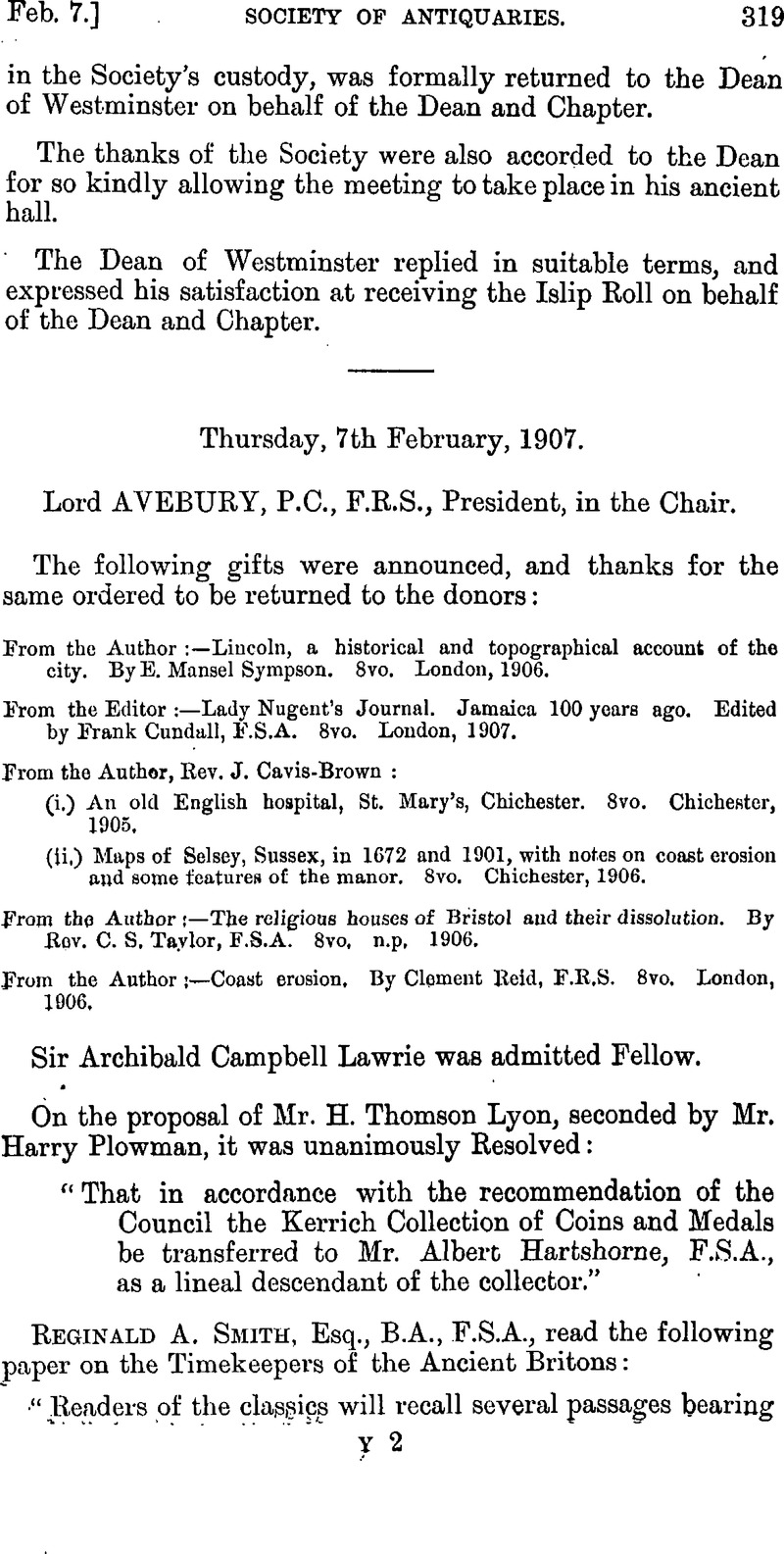No CrossRef data available.
Article contents
Thursday, 7th February, 1907
Published online by Cambridge University Press: 10 May 2010
Abstract

- Type
- Proceedings
- Information
- Copyright
- Copyright © The Society of Antiquaries of London 1905
References
page 321 note * Bk. ii. cap. 2. Hi terrae mundique magnitudinem et formam, motus cœli ac siderum, ac quod dii velunt scire profitentur.
page 321 note † De Bello Gallico, vi. caps. 13–15.
page 322 note * Astronomisches aus Babylon.
page 322 note † Lockyer, Dawn of Astronomy, 3.
page 322 note ‡ Marquardt and Mommsen, Handbuch der römischen Alterthümer, vii. 769–771. For Roman clepsydrae, see Archæological Journal, xxi. 139.
page 322 note § Larousse, Grand dictionnaire universel: elle (la clepsydre) était connue dans les Gaules avant l'arrivée de César, qui fut étonné de l'y trouver.
page 323 note * Livy, xliv. 37.
page 323 note † Les Druides et les dieux celtiques, 12, 23.
page 324 note * ii. 47.
page 324 note † Ammianus Marcellinus, xv. cap. ix. 8 (Erfurdt, i. 157).
page 324 note ‡ Bk. ii. cap. 109.
page 325 note * Owen and Blakeway, History of Shrewsbury, i. 8 (note).
page 325 note † Salopia Antiqua, 175. He suggests that the name is from Burth, an enclosure (p. 174).
page 326 note * Mr. Bruce Bannerman, F.S.A., has called my attention to one at the Horological Institute (45 minutes to fill) ; and my brother, a resident in Ceylon, has collected information on the spot. There are three in Colombo Museum, and one at Kandy.
page 326 note † Warm water would sink the bowl in less time, a fact known to Athenæus, who wrote in the first century of our era (ii. 42).
page 326 note ‡ Ethnographic Notes on Southern India, 562–6.
page 327 note * Translation from Sanskrit by Burgess and Whitney (1860), p. 264 ; Journal of American Oriental Society, vol. vi. cap. xiii. verse 23.
page 328 note * The weights and measures are computed from tables in Journal of Asiatic Society of Bengal, xxxiii. 264, and Balfour's Cyclopædia of India.
page 328 note † Varāha Mihira's Brihat-samhitā, Vizianagram Sanskrit Series, i. 67.
page 329 note * Ulster Journal of Archæology, ix. (1903), 138Google Scholar.
page 329 note † Edin. Mus. Cat. DU 3, 5 ; DW 1, 87.
page 330 note * Collection of the late Rev. S. M. Mayhew.
page 330 note † μλιστα δ’ αὐτοῖς αἱ λμναι τν συλαν παρεῖχον, εἰς ἅς ϰαθεσαν ργρου ἥ ϰα χρυσο βρη. Müller, Frag, Hist. Grace, iii. 261. The treasure found on the border of the lake of Soings, Selles-sur-Cher (Loir-et-Cher) seems to be a case in point; Revue Numismatique, 1836, pp. 79, 85–87, pl. ii.
page 330 note ‡ Hist. Phil. Epit. xxxii. 3.
page 331 note * A specimen in the British Museum was found in Lisnacrogher bog, Co. Antrim, just outside a crannog. It weighs about 6¼ oz. Av., and is 6¼ in. in diameter, with a sunk moulding below the rim, and an indented and perforated base slightly engraved with a geometrical pattern ; it takes 20½ min. to sink.
page 331 note † Edinb. Mus. Cat. p. 160.
page 331 note ‡ Proceedings of the Society of Antiquaries of Scotland, i. (1852), 43 ; do xix. (1884–5), 311, from moss at Kyleakin, Skye.
page 331 note § Figured in Proc. Soc. Ant. Scot., xxxix. (1905), 372 (4 in. diam).
page 331 note ‖ S. Müller, Nordische Altertumskunde, ii. 76, fig. 106 ; max, diam. 22¼ in.
page 332 note * No. 91283 ; exhibition No. 356, case 26.
page 332 note † Chinese Repository, xx, (1851), 428Google Scholar.
page 333 note * Nat. Hist. xxx. 1 : Britannia hodie eam (Magiam) attonite celebrat tantis ceremonüs, ut eam Persis dedisse videri possit. This was written some time before 79 A.D.
page 333 note † Pythagoras and India.




